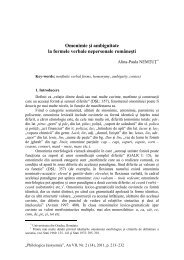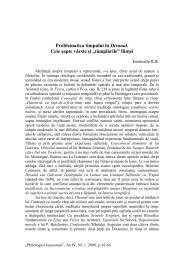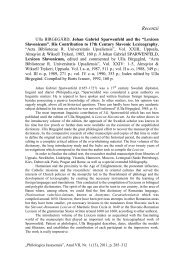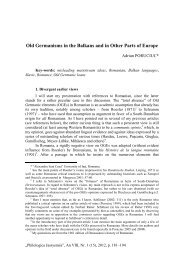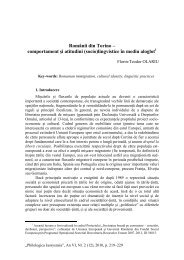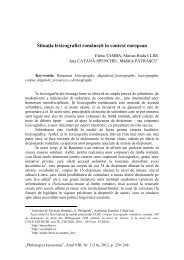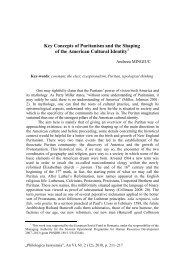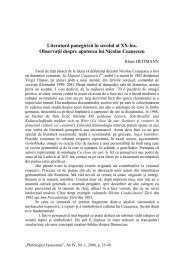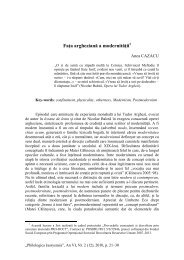The Vlach on line Dictionary - Philologica Jassyensia
The Vlach on line Dictionary - Philologica Jassyensia
The Vlach on line Dictionary - Philologica Jassyensia
You also want an ePaper? Increase the reach of your titles
YUMPU automatically turns print PDFs into web optimized ePapers that Google loves.
Vorbarĭ Rumîńesk: <str<strong>on</strong>g>The</str<strong>on</strong>g> <str<strong>on</strong>g>Vlach</str<strong>on</strong>g> <strong>on</strong> <strong>line</strong> Dicti<strong>on</strong>ary<br />
„<strong>Philologica</strong> <strong>Jassyensia</strong>”, An VIII, Nr. 1 (15), 2012, p. 47−60<br />
Annemarie SORESCU-MARINKOVIĆ �<br />
Key-words: <str<strong>on</strong>g>Vlach</str<strong>on</strong>g>s of North-Eastern Serbia, <str<strong>on</strong>g>Vlach</str<strong>on</strong>g> linguistic variety,<br />
lexicography, <strong>on</strong> <strong>line</strong> dicti<strong>on</strong>aries<br />
1. Language c<strong>on</strong>text<br />
<str<strong>on</strong>g>The</str<strong>on</strong>g> <str<strong>on</strong>g>Vlach</str<strong>on</strong>g>s (Vlasi, as they call themselves when speaking Serbian, or rumâń,<br />
which is the ethn<strong>on</strong>ym they use for self-identificati<strong>on</strong> when speaking their mother<br />
t<strong>on</strong>gue) are <strong>on</strong>e of the three main Romanian speaking communities <strong>on</strong> the territory<br />
of Serbia, apart from the Romanians of Vojvodina and the Bayash or Rudari, spread<br />
all over the country 1 . <str<strong>on</strong>g>The</str<strong>on</strong>g>y inhabit more than 100 villages in the North-Eastern part<br />
of Serbia, al<strong>on</strong>g the state border with Romania and Bulgaria, and speak an archaic<br />
variant of Daco-Romanian, with a great share of neologisms from the c<strong>on</strong>tact<br />
Serbian language. Almost all of them are bilingual, with <strong>on</strong>ly a few excepti<strong>on</strong>s in the<br />
very old or very young generati<strong>on</strong>s, which speak either <strong>on</strong>ly Romanian, or <strong>on</strong>ly<br />
Serbian. <str<strong>on</strong>g>The</str<strong>on</strong>g> <str<strong>on</strong>g>Vlach</str<strong>on</strong>g>s do not use their native vernaculars as a written language, as<br />
they are exclusively schooled in Serbian, nor do they have a traditi<strong>on</strong> of literacy in<br />
their native dialect.<br />
From a strictly linguistic and genealogic point of view, the <str<strong>on</strong>g>Vlach</str<strong>on</strong>g> cannot be<br />
called a language of its own, as it does not represent, at any level, an aut<strong>on</strong>omous<br />
linguistic unity: it is an archaic, dialectal, but still living variant of the Romanian<br />
language. <str<strong>on</strong>g>The</str<strong>on</strong>g> same holds true for the Bayash speeches of Serbia, which<br />
cannot be c<strong>on</strong>sidered as c<strong>on</strong>stituting a language separate from Romanian, since<br />
they have preserved the crucial features (syntactic and morphological) of the<br />
Romanian language, the most important changes occurring in the lexic<strong>on</strong>, because of<br />
the need to borrow new words (Sorescu-Marinković 2011: 20).<br />
Nevertheless, this perspective might change in respect to the definiti<strong>on</strong> of<br />
language and languageness, for it must not be forgotten that language is not<br />
(entirely) a linguistic phenomen<strong>on</strong>, but a social and political <strong>on</strong>e. <str<strong>on</strong>g>The</str<strong>on</strong>g> recent split of<br />
the Serbo-Croatian language in four different languages – Serbian, Croatian,<br />
Bosnian and M<strong>on</strong>tenegrin –, even if the same subdialect of Shtokavian is the basis<br />
of all four of them, is a good example in this respect: even if they all are mutually<br />
intelligible and c<strong>on</strong>stitute a single language by a purely linguistic criteri<strong>on</strong>, they are,<br />
� <str<strong>on</strong>g>The</str<strong>on</strong>g> Institute for Balkan Studies, Belgrade, Serbia.<br />
1 For more details <strong>on</strong> the Romanian speaking communities in Serbia, see Sorescu-Marinković 2007<br />
and Sikimić 2012.
Annemarie SORESCU-MARINKOVIĆ<br />
however, distinct nati<strong>on</strong>al standards. Since a ‘standard language’ can act as a symbol<br />
of independence, many groups are keen to keep their language separate from others,<br />
despite being practically identical.<br />
If we take Romanian and its varieties, we might menti<strong>on</strong> the example of the<br />
Bayash vernaculars from Hungary, which are today a standardized language. Even if<br />
they are archaic variants of the Romanian language, with a str<strong>on</strong>g influence of the<br />
c<strong>on</strong>tact Hungarian language, the Bayash do not have a Romanian nati<strong>on</strong>al identity,<br />
thus the adopti<strong>on</strong> of the standard Romanian (already in use with the Romanian<br />
minority from Hungary) did not seem acceptable to them. <str<strong>on</strong>g>The</str<strong>on</strong>g> use of a certain<br />
language and the feeling of bel<strong>on</strong>ging to a nati<strong>on</strong> do not always run together.<br />
As linguistics is a descriptive, rather than a prescriptive discip<strong>line</strong>, and in order<br />
to avoid any biases, we shall refer to the <str<strong>on</strong>g>Vlach</str<strong>on</strong>g> vernaculars not as the “<str<strong>on</strong>g>Vlach</str<strong>on</strong>g> language”<br />
nor as “Romanian dialects”, but as the “<str<strong>on</strong>g>Vlach</str<strong>on</strong>g> variety of the Romanian language”.<br />
<str<strong>on</strong>g>The</str<strong>on</strong>g> <str<strong>on</strong>g>Vlach</str<strong>on</strong>g> variety of the Romanian language can be c<strong>on</strong>sidered heritage language,<br />
following the widely accepted definiti<strong>on</strong> by Valdes (2000) that a heritage language<br />
is a language which is acquired by individuals raised in homes where the dominant<br />
language of the regi<strong>on</strong> is not spoken or not exclusively spoken. A heritage language<br />
is typically acquired before a dominant language, but is not completely acquired<br />
because of the individual’s switch to that dominant language (Polinsky/ Kagan 2007).<br />
2. Attempts at standardizing the <str<strong>on</strong>g>Vlach</str<strong>on</strong>g> variety<br />
<str<strong>on</strong>g>The</str<strong>on</strong>g> <str<strong>on</strong>g>Vlach</str<strong>on</strong>g> variety lacks a substantial record of previous documentati<strong>on</strong>. <str<strong>on</strong>g>The</str<strong>on</strong>g><br />
researchers who studied this regi<strong>on</strong> documented mainly traditi<strong>on</strong>al speech genres<br />
(Vâlsan 1913 /2001/, Petrovici 1942), and not so much the spoken everyday<br />
language. Before WWI, the Romanian linguist George Vâlsan, after field researches<br />
in the area, established that the <str<strong>on</strong>g>Vlach</str<strong>on</strong>g>s speak two different dialects of the Romanian<br />
language: the Bănăţean dialect and the Muntean <strong>on</strong>e (Vâlsan 1913 /2001/: 266).<br />
Recent ethnolinguistic researches (Durlić 2010, Petrović 2005, Sikimić 2005,<br />
Sorescu-Marinković 2006) nuanced the findings of Vâlsan, ascertaining that the<br />
<str<strong>on</strong>g>Vlach</str<strong>on</strong>g>s bel<strong>on</strong>g to four dialectal groups: Ţăranii, Ungurenii, Ungurenii-Munteni and<br />
Bufanii. Ungurenii inhabit mainly the regi<strong>on</strong>s of Braničevo, Stig, Zvižd, Mlava,<br />
Resava and Homolje, and speak a dialect which is closely c<strong>on</strong>nected to the Bănăţean<br />
dialect of the Romanian language; the speech of Ţărani, living in Ključ and Krajina<br />
regi<strong>on</strong>s, resemble the Muntean dialect; while the mixtures between Ungureni and<br />
Ţărani gave rise to a transiti<strong>on</strong> dialect, that of the Ungureni-Munteni. Bufanii are a<br />
distinct populati<strong>on</strong> group, the most recent settlers from Romania, who today live<br />
<strong>on</strong>ly in the town of Majdanpek and have been almost completely assimilated by the<br />
most numerous Ungureni, as far as their native vernacular is c<strong>on</strong>cerned (Sikimić<br />
2005: 149, Sorescu-Marinković 2009: 189–190).<br />
<str<strong>on</strong>g>The</str<strong>on</strong>g> preparati<strong>on</strong>s for the field researches for the Romanian Linguistic Atlas –<br />
regi<strong>on</strong> Morava, Danube, Timok (ALR – MDT) started more than seven years ago.<br />
ALR – MDT is meant to be a regi<strong>on</strong>al atlas of the Romanian language, similar to<br />
other atlases from the series, which depict dialects spoken <strong>on</strong> the territory of<br />
Romania. <str<strong>on</strong>g>The</str<strong>on</strong>g> recordings are supposed to be carried out in 60 localities, with the<br />
help of a questi<strong>on</strong>naire comprising 1,111 questi<strong>on</strong>s (Neiescu/ Beltechi/ Mocanu 2006).<br />
48
“Vorbarĭ Rumîńesk”: <str<strong>on</strong>g>The</str<strong>on</strong>g> <str<strong>on</strong>g>Vlach</str<strong>on</strong>g> <strong>on</strong> <strong>line</strong> Dicti<strong>on</strong>ary<br />
Until now, serious linguistic research in the area was sporadic, and the bulk of<br />
the documentary linguistic and ethnographic material remained unpublished, in the<br />
archives of various instituti<strong>on</strong>s or individuals. <str<strong>on</strong>g>The</str<strong>on</strong>g>re have been attempts at issuing<br />
periodicals in the <str<strong>on</strong>g>Vlach</str<strong>on</strong>g> variety, but they have failed in the l<strong>on</strong>g run. <str<strong>on</strong>g>The</str<strong>on</strong>g> visitors of<br />
several <str<strong>on</strong>g>Vlach</str<strong>on</strong>g> forums use their native vernaculars, most of whom transliterate them<br />
with the help of the Cyrillic alphabet, but there are no standards. Ljubiša lu Boža<br />
Kići, member of the <str<strong>on</strong>g>Vlach</str<strong>on</strong>g> community and amateur linguist, compiled a <str<strong>on</strong>g>Vlach</str<strong>on</strong>g>-<br />
Serbian and Serbian-<str<strong>on</strong>g>Vlach</str<strong>on</strong>g> dicti<strong>on</strong>ary (<str<strong>on</strong>g>Vlach</str<strong>on</strong>g> Dicti<strong>on</strong>ary 2004) and translated the<br />
Bible into <str<strong>on</strong>g>Vlach</str<strong>on</strong>g> (<str<strong>on</strong>g>Vlach</str<strong>on</strong>g> Bible 2006), <strong>on</strong> the basis of his pers<strong>on</strong>al system of<br />
transcripti<strong>on</strong> for the <str<strong>on</strong>g>Vlach</str<strong>on</strong>g> variety which combines Cyrillic, Latin and special characters.<br />
In spite of the lack of documentati<strong>on</strong> about the <str<strong>on</strong>g>Vlach</str<strong>on</strong>g> variety, the<br />
standardizati<strong>on</strong> of the <str<strong>on</strong>g>Vlach</str<strong>on</strong>g> language is currently taking place, a process<br />
accompanied by intense debates, partly due to the fragmentati<strong>on</strong> of the <str<strong>on</strong>g>Vlach</str<strong>on</strong>g><br />
community, and partly to the delicate political c<strong>on</strong>text 2 . On December 8 th 2011, the<br />
Nati<strong>on</strong>al Council of the <str<strong>on</strong>g>Vlach</str<strong>on</strong>g>s unanimously adopted the Proposal for the <str<strong>on</strong>g>Vlach</str<strong>on</strong>g><br />
writing, developed by the Associati<strong>on</strong> “Gergina” from Negotin (Proposal 2011).<br />
According to the Proposal…, the “<str<strong>on</strong>g>Vlach</str<strong>on</strong>g> language is the term used for archaic<br />
Roman dialects which the <str<strong>on</strong>g>Vlach</str<strong>on</strong>g>s of North-Eastern Serbia speak as their mother<br />
t<strong>on</strong>gue”. Further, the document claims that,<br />
despite the fact that the language of the <str<strong>on</strong>g>Vlach</str<strong>on</strong>g>s of Serbia is an idiom (dialect)<br />
which resulted from the Balkan Latinity, partly from Romanian and partly with<br />
influences from n<strong>on</strong>-Romance languages, it is specific enough to be c<strong>on</strong>sidered the<br />
mother t<strong>on</strong>gue of the <str<strong>on</strong>g>Vlach</str<strong>on</strong>g>s.<br />
<str<strong>on</strong>g>The</str<strong>on</strong>g> authors of the Proposal… also menti<strong>on</strong> the fact that the <str<strong>on</strong>g>Vlach</str<strong>on</strong>g> language is<br />
comprised of two dialects: that spoken in the Homoljsko-Braničevsko district and<br />
the <strong>on</strong>e from the Krajinsko-Timočko regi<strong>on</strong>.<br />
<str<strong>on</strong>g>The</str<strong>on</strong>g> document states that the adopti<strong>on</strong> of the <str<strong>on</strong>g>Vlach</str<strong>on</strong>g> system of writing is a<br />
“priority and urgent task”, as it represents “the pinnacle and foundati<strong>on</strong> of literacy<br />
and language preservati<strong>on</strong>”. As its authors suggest, the <str<strong>on</strong>g>Vlach</str<strong>on</strong>g> writing must be based<br />
<strong>on</strong> well known graphical soluti<strong>on</strong>s, namely <strong>on</strong> the equal use of the Cyrillic and Latin<br />
alphabets, and must corresp<strong>on</strong>d to the linguistic and ph<strong>on</strong>etic features of the <str<strong>on</strong>g>Vlach</str<strong>on</strong>g><br />
language. Thus, two systems of writing were adopted: the Cyrillic and the Latin <strong>on</strong>e,<br />
both based <strong>on</strong> ph<strong>on</strong>etic principles. <str<strong>on</strong>g>The</str<strong>on</strong>g> Cyrillic <str<strong>on</strong>g>Vlach</str<strong>on</strong>g> writing comprises 34<br />
m<strong>on</strong>ographemes (from the Serbian Cyrillic) and <strong>on</strong>e digrapheme, dz. <str<strong>on</strong>g>The</str<strong>on</strong>g> Latin<br />
<str<strong>on</strong>g>Vlach</str<strong>on</strong>g> writing comprises 31 m<strong>on</strong>ographemes and four digraphemes: dž, lj, nj and dz;<br />
the additi<strong>on</strong>al vowels, apart from the Serbian <strong>on</strong>es (a, e, i, o, u), for both dialectal<br />
2 On February 28th 2012, Romania forced a delay of Serbia being granted the candidate country<br />
status to the European Uni<strong>on</strong> membership, following a dramatic meeting of the EU foreign ministers in<br />
Brussels. Bucharest insisted that before getting the candidate country status, Serbia had to improve the<br />
situati<strong>on</strong> of the <str<strong>on</strong>g>Vlach</str<strong>on</strong>g> minority. Romania’s stance was criticized by the German Foreign Minister, but<br />
also by the leader of the <str<strong>on</strong>g>Vlach</str<strong>on</strong>g> Nati<strong>on</strong>al Council in Serbia, Radiša Dragojević, who said that <strong>on</strong>ly a<br />
small group of <str<strong>on</strong>g>Vlach</str<strong>on</strong>g>s c<strong>on</strong>sider themselves Romanians and asked for Romania’s help and that Romania<br />
had no right in giving ultimatums to Serbia. After the signing of a bilateral agreement at the<br />
ambassadorial level, providing for the better protecti<strong>on</strong> for the <str<strong>on</strong>g>Vlach</str<strong>on</strong>g> minority in Serbia, Serbia was<br />
granted full candidate country status <strong>on</strong> March 1st.<br />
49
Annemarie SORESCU-MARINKOVIĆ<br />
areas, are ă and î, while the additi<strong>on</strong>al c<strong>on</strong>s<strong>on</strong>ants, characteristic <strong>on</strong>ly for the<br />
Homoljsko-Braničevsko dialect, are dz, ś and ź.<br />
3. <str<strong>on</strong>g>The</str<strong>on</strong>g> <str<strong>on</strong>g>Vlach</str<strong>on</strong>g> <strong>on</strong> <strong>line</strong> dicti<strong>on</strong>ary (VOD)<br />
C<strong>on</strong>currently with the official attempts at standardizati<strong>on</strong> of the <str<strong>on</strong>g>Vlach</str<strong>on</strong>g><br />
language, another lexicographic project started in mid-2011: the compilati<strong>on</strong> of<br />
Vorbarĭ rumîńesk, the <str<strong>on</strong>g>Vlach</str<strong>on</strong>g> <strong>on</strong> <strong>line</strong> dicti<strong>on</strong>ary (VOD). As opposed to the<br />
standardizati<strong>on</strong> of the <str<strong>on</strong>g>Vlach</str<strong>on</strong>g> language, which was carried out at instituti<strong>on</strong>al level,<br />
VOD is a pers<strong>on</strong>al pilot project, designed and administered by the enthusiastic<br />
<str<strong>on</strong>g>Vlach</str<strong>on</strong>g> ethnologist Paun Es Durlić, without any instituti<strong>on</strong>al or political support.<br />
VOD was announced in the Compendium for the introducti<strong>on</strong> of <str<strong>on</strong>g>Vlach</str<strong>on</strong>g> in primary<br />
schools (Durlić 2011), a manifest and proposal for the preservati<strong>on</strong> and revival of<br />
the mother t<strong>on</strong>gue of the <str<strong>on</strong>g>Vlach</str<strong>on</strong>g>s, and is being created according to the principles<br />
explained there in detail by its author.<br />
3.1. <str<strong>on</strong>g>The</str<strong>on</strong>g> Compendium<br />
As Durlić says in the Compendium..., by all ethnographic features (language,<br />
beliefs, customs, material culture etc.), “the <str<strong>on</strong>g>Vlach</str<strong>on</strong>g>s are part of the Romanian people,<br />
as follows: the Eastern <str<strong>on</strong>g>Vlach</str<strong>on</strong>g>s, the so-called Ţărani, bel<strong>on</strong>g to the Olteni group,<br />
while both Ungureni groups bel<strong>on</strong>g to the Bănăţeni” (idem: 1). Further, Durlić<br />
asserts that the “<str<strong>on</strong>g>Vlach</str<strong>on</strong>g> language” is a language <strong>on</strong>ly in the ethno-historical c<strong>on</strong>text,<br />
while linguistically it is comprised of two dialects of the Romanian language:<br />
Western <str<strong>on</strong>g>Vlach</str<strong>on</strong>g>s speak the Bănăţean dialect and Eastern <str<strong>on</strong>g>Vlach</str<strong>on</strong>g>s the Oltean dialect.<br />
As the Romanian literary language was created in the 19 th century <strong>on</strong> the basis of the<br />
Muntean dialect and this process did not involve the <str<strong>on</strong>g>Vlach</str<strong>on</strong>g>s, they “sense” it as a<br />
foreign language, c<strong>on</strong>sidering <strong>on</strong>ly its above-menti<strong>on</strong>ed dialects as their mother<br />
t<strong>on</strong>gue. <str<strong>on</strong>g>The</str<strong>on</strong>g> author goes <strong>on</strong> to define the “<str<strong>on</strong>g>Vlach</str<strong>on</strong>g> language”: “the Serbian popular<br />
name for the dialects of the Romanian language which the <str<strong>on</strong>g>Vlach</str<strong>on</strong>g>s of North-Eastern<br />
Serbia speak as their mother t<strong>on</strong>gue” (idem: 2). As far as the ethnic identity of the<br />
<str<strong>on</strong>g>Vlach</str<strong>on</strong>g>s is c<strong>on</strong>cerned, Durlić classifies nowadays <str<strong>on</strong>g>Vlach</str<strong>on</strong>g>s in the group of peoples with<br />
a so-called double identity, where <strong>on</strong>e can distinguish three levels: ethnic instinct,<br />
ethnic c<strong>on</strong>sciousness and nati<strong>on</strong>al c<strong>on</strong>sciousness. Thus, according to the ethnic<br />
instinct and ethnic c<strong>on</strong>sciousness, the <str<strong>on</strong>g>Vlach</str<strong>on</strong>g>s bel<strong>on</strong>g to the Romanian people, but<br />
according to the nati<strong>on</strong>al c<strong>on</strong>sciousness, they are Serbs. Or more picturesquely said,<br />
as the author of the Compendium... c<strong>on</strong>veys it,<br />
the c<strong>on</strong>temporary <str<strong>on</strong>g>Vlach</str<strong>on</strong>g>s are Romanians <strong>on</strong> two «floors» and Serbians at the<br />
third <strong>on</strong>e, the “roof floor”, which means that the <str<strong>on</strong>g>Vlach</str<strong>on</strong>g>s do not have a Romanian<br />
nati<strong>on</strong>al c<strong>on</strong>sciousness, because it – like any other nati<strong>on</strong>al c<strong>on</strong>sciousness – is formed<br />
during complex historical processes (idem: 2) 3 .<br />
<str<strong>on</strong>g>The</str<strong>on</strong>g> author thinks the specific ethnic mimicry of the <str<strong>on</strong>g>Vlach</str<strong>on</strong>g>s is the reas<strong>on</strong> why<br />
the results of populati<strong>on</strong> censuses from Serbia are never precise as far as the number<br />
of <str<strong>on</strong>g>Vlach</str<strong>on</strong>g>s is c<strong>on</strong>cerned.<br />
3 It is important to note that the famous Romanian geographer George Vâlsan, almost a century<br />
ago, noted the lack of Romanian nati<strong>on</strong>al counsciousness am<strong>on</strong>g the <str<strong>on</strong>g>Vlach</str<strong>on</strong>g>s, which was however<br />
counterbalanced by a str<strong>on</strong>g ethnical instinct (Vâlsan 1913 /2001/: 85).<br />
50
“Vorbarĭ Rumîńesk”: <str<strong>on</strong>g>The</str<strong>on</strong>g> <str<strong>on</strong>g>Vlach</str<strong>on</strong>g> <strong>on</strong> <strong>line</strong> Dicti<strong>on</strong>ary<br />
Durlić also believes that the <str<strong>on</strong>g>Vlach</str<strong>on</strong>g> dialects are almost obsolete and cannot be<br />
revived by the standard Romanian language, as the former Nati<strong>on</strong>al Council of the<br />
<str<strong>on</strong>g>Vlach</str<strong>on</strong>g>s proposed, nor by transforming them in an official language, as the new<br />
Council expects. Instead, he suggests a model of language reviving, with two main<br />
aims: 1) to create a favorable atmosphere for overcoming the huge gap between<br />
generati<strong>on</strong>s, so they c<strong>on</strong>tinue to use the <str<strong>on</strong>g>Vlach</str<strong>on</strong>g> dialects as part of their ethnic<br />
intimacy, and 2) to get the young <str<strong>on</strong>g>Vlach</str<strong>on</strong>g>s acquainted with Romanian literary<br />
language, which is, in methodological terms, a partially foreign language for them.<br />
Durlić also proposes an educati<strong>on</strong>al model and a learning dynamics for pupils in<br />
primary schools, also advocating the use of the two alphabets the <str<strong>on</strong>g>Vlach</str<strong>on</strong>g>s are familiar<br />
with: the Cyrillic and Latin <strong>on</strong>e, with slight modificati<strong>on</strong>s. As said in the<br />
Compendium…, he intended the VOD to be a useful learning tool for the <str<strong>on</strong>g>Vlach</str<strong>on</strong>g>s<br />
who get familiar with their dialects and with the Romanian language.<br />
3.2. <str<strong>on</strong>g>The</str<strong>on</strong>g> structure of VOD<br />
VOD is hosted <strong>on</strong> the pers<strong>on</strong>al website of its initiator and administrator, Paun<br />
Es Durlić, www.paundurlic.com, and its homepage looks like this:<br />
Figure 1. <str<strong>on</strong>g>The</str<strong>on</strong>g> homepage of the <str<strong>on</strong>g>Vlach</str<strong>on</strong>g> <strong>on</strong>-<strong>line</strong> dicti<strong>on</strong>ary<br />
(http://www.paundurlic.com/vlaski.recnik/)<br />
51
Annemarie SORESCU-MARINKOVIĆ<br />
<str<strong>on</strong>g>The</str<strong>on</strong>g> image <strong>on</strong> the homepage is a portrait of the administrator’s grandfather,<br />
which, as he c<strong>on</strong>fesses, reminds him that he has the moral duty to preserve the<br />
language legacy that was handed to him. <str<strong>on</strong>g>The</str<strong>on</strong>g> emotic<strong>on</strong> at the right side of the<br />
portrait is the trademark of VOD, created by Durlić al<strong>on</strong>e, and the slogan that<br />
usually goes with the sign reads: “Vlaĭku rumînu skriĭaşće rumîńaşće!” (“<str<strong>on</strong>g>The</str<strong>on</strong>g> <str<strong>on</strong>g>Vlach</str<strong>on</strong>g><br />
Romanian writes in Romanian!”).<br />
VOD offers the possibility of changing the language interface: Rumîńaşće<br />
(<str<strong>on</strong>g>Vlach</str<strong>on</strong>g>), Româneşte (Romanian) and Српски (Serbian). <str<strong>on</strong>g>The</str<strong>on</strong>g>re are 17 available<br />
opti<strong>on</strong>s: Listing, Search, New word, Correcti<strong>on</strong>s, Folk literature, Forum, Help,<br />
Administrati<strong>on</strong>, About us, About the language, C<strong>on</strong>tact, Pr<strong>on</strong>ounciati<strong>on</strong>, Links,<br />
Motto, Download, Literature and Writing school.<br />
<str<strong>on</strong>g>The</str<strong>on</strong>g> first opti<strong>on</strong>, Listing, offers the visitors of the site the possibility to list the<br />
existing words by: Latin <str<strong>on</strong>g>Vlach</str<strong>on</strong>g>, Cyrillic <str<strong>on</strong>g>Vlach</str<strong>on</strong>g>, Serbian translati<strong>on</strong>, their usage in<br />
proverbs, illustrated words, the name of the c<strong>on</strong>tributor who entered the word, the<br />
village where the word was collected, number of visits for <strong>on</strong>e word, as well as a<br />
printable form of the dicti<strong>on</strong>ary.<br />
<str<strong>on</strong>g>The</str<strong>on</strong>g> opti<strong>on</strong> Search, apart from offering the possibility to query the lexic<strong>on</strong><br />
database by word, prefix, suffix, the Romanian or Serbian translati<strong>on</strong> of the word,<br />
number of the word or geographical regi<strong>on</strong>, also comprises interactive maps which<br />
offer the visitors the possibility to query the lexicographic material by clicking <strong>on</strong><br />
the regi<strong>on</strong>s <strong>on</strong> the map.<br />
Figure 2. Interactive map of the regi<strong>on</strong>s inhabited by <str<strong>on</strong>g>Vlach</str<strong>on</strong>g>s and of the <str<strong>on</strong>g>Vlach</str<strong>on</strong>g> groups<br />
(http://www.paundurlic.com/vlaski.recnik/pretraga.php)<br />
52<br />
’
“Vorbarĭ Rumîńesk”: <str<strong>on</strong>g>The</str<strong>on</strong>g> <str<strong>on</strong>g>Vlach</str<strong>on</strong>g> <strong>on</strong> <strong>line</strong> Dicti<strong>on</strong>ary<br />
<str<strong>on</strong>g>The</str<strong>on</strong>g> author categorizes the <str<strong>on</strong>g>Vlach</str<strong>on</strong>g>s, according to the geographical areas of<br />
North-Eastern Serbia they inhabit, into three main groups: 1) Eastern, 2) Central and<br />
3) Western <str<strong>on</strong>g>Vlach</str<strong>on</strong>g>s. <str<strong>on</strong>g>The</str<strong>on</strong>g> linguistic groups presented <strong>on</strong> the map are: Ungureni<br />
(Bănăţeni) <str<strong>on</strong>g>Vlach</str<strong>on</strong>g>s, Munteni (Bănăţeni) <str<strong>on</strong>g>Vlach</str<strong>on</strong>g>s, Ţărani (Olteni) <str<strong>on</strong>g>Vlach</str<strong>on</strong>g>s, Bufani<br />
<str<strong>on</strong>g>Vlach</str<strong>on</strong>g>s, Bayash (Romanian speaking Roma) and Serbs. By clicking <strong>on</strong> <strong>on</strong>e of the 17<br />
sub-regi<strong>on</strong>s <strong>on</strong> the map, <strong>on</strong>e gets more detailed micro-maps, with further<br />
categorizati<strong>on</strong>s of the <str<strong>on</strong>g>Vlach</str<strong>on</strong>g>s (as we can see from Figure 3 – Pădureni, Câmpeni,<br />
Timoceni, for example, in the Negotinska krajina and Timok regi<strong>on</strong>s), a complete<br />
network of settlements, and the possibility to click <strong>on</strong> them and to visualize the<br />
entire lexicographic material collected there or c<strong>on</strong>nected with that particular place<br />
(see Figure 4).<br />
Figure 3. Detailed interactive map of the Negotinska krajina and Timok regi<strong>on</strong>s<br />
(http://www.paundurlic.com/vlaski.recnik/mapa-timoceni.php)<br />
53
Annemarie SORESCU-MARINKOVIĆ<br />
Figure 4. Lexicographic material collected in or c<strong>on</strong>nected to the village of Radujevac<br />
(http://www.paundurlic.com/vlaski.recnik/pretraga_rez_mapa.php?uneta_rec=Radujevac)<br />
In the Folk literature opti<strong>on</strong>, we can find entire texts bel<strong>on</strong>ging to different<br />
domains of the folk literature, accompanied by the categorizati<strong>on</strong> of the texts, <str<strong>on</strong>g>Vlach</str<strong>on</strong>g><br />
original title and Serbian translati<strong>on</strong>, the comment of the author regarding various<br />
aspects of the folk creati<strong>on</strong> and, in some cases, the original audio recording of the text.<br />
Another interesting feature is the Pr<strong>on</strong>unciati<strong>on</strong> opti<strong>on</strong>, which offers the<br />
visitor the possibility to listen to the ph<strong>on</strong>etic reproducti<strong>on</strong> of lexemes or of entire<br />
folk texts.<br />
On the homepage there are listed the letters of the <str<strong>on</strong>g>Vlach</str<strong>on</strong>g> alphabet, as Durlić<br />
c<strong>on</strong>ceived it, in both Latin and Cyrillic variants, although prevalence is given to<br />
Latin. As for the Latin <str<strong>on</strong>g>Vlach</str<strong>on</strong>g> alphabet, it is a mixture of Serbian Latin characters (č,<br />
ć, đ, ž), Romanian letters (ă, î, ş, ţ), as well as other special characters, bel<strong>on</strong>ging to<br />
the internati<strong>on</strong>al ph<strong>on</strong>etic transcripti<strong>on</strong> system (ğ, ḑ, ď, ĭ, ļ, ń, ś, ť, ź). <str<strong>on</strong>g>The</str<strong>on</strong>g> Cyrillic<br />
<str<strong>on</strong>g>Vlach</str<strong>on</strong>g> alphabet c<strong>on</strong>tains, apart from the Cyrillic characters characteristic of the<br />
Serbian language, Latin characters from the Romanian language (ă, î), as well as<br />
from the internati<strong>on</strong>al system of ph<strong>on</strong>etic transcripti<strong>on</strong> (ḑ, ď, ś, ť, ź). <str<strong>on</strong>g>The</str<strong>on</strong>g>se last<br />
characters were introduced in the newly formed <str<strong>on</strong>g>Vlach</str<strong>on</strong>g> alphabet out of the need to<br />
cover all the <str<strong>on</strong>g>Vlach</str<strong>on</strong>g> sounds, which do not exist in the Serbian pr<strong>on</strong>unciati<strong>on</strong>, or in the<br />
Romanian standard, being characteristic <strong>on</strong>ly to some dialects (see, for example, the<br />
palatalized c<strong>on</strong>s<strong>on</strong>ants).<br />
On the home page of VOD there is also presented the last entry in the<br />
dicti<strong>on</strong>ary, as well as number of entries compiled so far.<br />
Each entry is introduced in <str<strong>on</strong>g>Vlach</str<strong>on</strong>g>, translated into Romanian and Serbian,<br />
explained in <str<strong>on</strong>g>Vlach</str<strong>on</strong>g> and in Serbian, exemplified through samples of free speech or as<br />
it appears in folk creati<strong>on</strong>s, according to the following model:<br />
(01) Main entry<br />
(01.1) <str<strong>on</strong>g>Vlach</str<strong>on</strong>g> word<br />
(01.2) Romanian translati<strong>on</strong><br />
(01.3) Serbian translati<strong>on</strong><br />
(02) “Word nest”<br />
(02.1) <str<strong>on</strong>g>Vlach</str<strong>on</strong>g> word singular<br />
(02.2) <str<strong>on</strong>g>Vlach</str<strong>on</strong>g> word plural<br />
(02.3) <str<strong>on</strong>g>Vlach</str<strong>on</strong>g> word with marked accents<br />
(02.4) Grammatical determinants (part of speech etc.)<br />
54
“Vorbarĭ Rumîńesk”: <str<strong>on</strong>g>The</str<strong>on</strong>g> <str<strong>on</strong>g>Vlach</str<strong>on</strong>g> <strong>on</strong> <strong>line</strong> Dicti<strong>on</strong>ary<br />
(02.5) Word explanati<strong>on</strong> in Serbian<br />
(02.6) Use of the word in expressi<strong>on</strong>s/idioms<br />
(02.7) Translati<strong>on</strong> of the idiom in Serbian<br />
(02.8) <str<strong>on</strong>g>The</str<strong>on</strong>g> regi<strong>on</strong> the word was collected<br />
(02.9) Lexical variants with other <str<strong>on</strong>g>Vlach</str<strong>on</strong>g> groups<br />
(03) Other elements: village, regi<strong>on</strong>, sub-regi<strong>on</strong>, for what domain of culture<br />
the word is characteristic, collector (author), literature, images, notes etc.<br />
Examples:<br />
Nouns:<br />
brĭazdă (mn. brîăžđ) [akc. brĭazdă] (i. ž.) — 1. brazda, udubljenje koje plug<br />
ostavlja na površini zemlje pri oranju ◊ kînd arĭ ku vićiļi, şî kînd plugu-ţ sîare đin<br />
brĭazdă, kî ĭe pomîntu tare, loko-la ńiarat în fundu brîažđi, sa kĭamă pîrś — kad oreš<br />
stokom, i kad ti plug iskoči iz brazde zbog tvrde zemlje, <strong>on</strong>aj nepoorani deo na dnu<br />
brazde zove se jarac 2. dugačak i uzan traga iza nekog predmeta koji se kretao ili<br />
koji je vučen ◊ a trĭekut kare a fi trĭekt ku saĭna pin namĭeţ, ş-a ramas brîăžđ adînś<br />
dupa ĭel — neko je prošao sankama kroz smetove, i ostavio duboke brazde za sobom<br />
◊ (demin.) brĭazduţă, brĭezduļeţ ◊ (augm.) brĭazduoń ◊ sin. şîrag [Por.]<br />
Verbs:<br />
brăzdui (brăzduĭaşće, brăzduĭesk) [akc. brăzdui] (gl. p.) — brazdati,<br />
povlačiti brazdu, orati ◊ pomîntu ĭe tare ka pĭatra, no sî sa puată brăzdui ļesńe —<br />
zemlja je tvrda kao kamen, neće moži lako da se izbrazda [Por.] ∞ brĭazdă<br />
Pr<strong>on</strong>ouns:<br />
aăla (аĭа) (mn. aăĭa, аăļа) [akc. aăla] (zam.) — <strong>on</strong>aj, <strong>on</strong>o; taj ◊ aăla uom —<br />
<strong>on</strong>aj čovek ◊ aăla kopil — <strong>on</strong>o dete ◊ aĭa muĭarĭe — <strong>on</strong>a žena ◊ aăļa muĭerĭ — <strong>on</strong>e<br />
žene [Por.] dij. var. ăla (aĭa) (mn. ăĭa, ăļa) [akc. ăla (aĭa)] [Kmp.]<br />
Adjectives:<br />
adînk (adînkă) (mn. adînś, adînśе) [akc. adînk] (prid.) — dubok, udubljen ◊<br />
apă adînkă — duboka voda ◊ padurĭe adînkă — gusta i velika šuma ◊ vaļe adînkă —<br />
duboka dolina ◊ suomn adînk — dubok san ◊ var. adînśuos (mn. adînśuasă) [akc.<br />
adînśuos] [Por.] dij. var. adînk (adînkă) (mn. adînč, adînčе) [akc. adînk] [Kmp.]<br />
(posl.) Ku bîtu skurt nu sa masură apa adînkă. — Kratkim štapom ne meri se duboka<br />
voda. (Rudna Glava, zapis: Durlić) [Por.]<br />
3.3. How is VOD being created<br />
As Durlić metaphorically says <strong>on</strong> the VOD site, “this dicti<strong>on</strong>ary, named<br />
vorbarĭ in the spirit of the <str<strong>on</strong>g>Vlach</str<strong>on</strong>g> people’s speech, is the initiative of an ethnologist,<br />
<str<strong>on</strong>g>Vlach</str<strong>on</strong>g> by origin, together with a group of enthusiasts, who bare handed take the<br />
<str<strong>on</strong>g>Vlach</str<strong>on</strong>g> words out of the language ruins, carefully examine what memories their last<br />
whisper brings to the people, and watchfully arrange them in the open treasury of<br />
the <str<strong>on</strong>g>Vlach</str<strong>on</strong>g> spiritual culture, which until now has been mysterious and unknown, but<br />
today is open to each of us <strong>on</strong> the Internet, and available to every<strong>on</strong>e!”. Am<strong>on</strong>g the<br />
people involved with the creati<strong>on</strong> of VOD there are, first of all, many engaged<br />
participants from the <str<strong>on</strong>g>Vlach</str<strong>on</strong>g> community, who introduce in the dicti<strong>on</strong>ary words from<br />
their villages of origin; then, there are the researchers who act as c<strong>on</strong>sultants in<br />
linguistic issues; and, finally, there is the creator and administrator of VOD, also a<br />
55
Annemarie SORESCU-MARINKOVIĆ<br />
community member, ethnologist and programmer, under whose supervisi<strong>on</strong> the<br />
lexic<strong>on</strong> is being created. <str<strong>on</strong>g>The</str<strong>on</strong>g> documentati<strong>on</strong> database for VOD is represented by<br />
samples of free speech from the members of the community, registered users, who<br />
exemplify different entries in the dicti<strong>on</strong>ary with lexemes from their own local<br />
dialect, and by a corpus of audio recordings, made during ethnological field<br />
researchers and bel<strong>on</strong>ging to the initiator and administrator of the site.<br />
Figure 5. Example of entry in VOD, palenta<br />
(http://www.paundurlic.com/vlaski.recnik/celarec.php?acti<strong>on</strong>=upd&id=28)<br />
3.4. <str<strong>on</strong>g>The</str<strong>on</strong>g> dynamics of VOD<br />
<str<strong>on</strong>g>The</str<strong>on</strong>g> compilati<strong>on</strong> of the dicti<strong>on</strong>ary started in mid-2011 and by November 13th<br />
2011 there were 500 words compiled in it, while the number of visitors reached<br />
1,300 (the main visitor counter of the dicti<strong>on</strong>ary is designed to count <strong>on</strong>ly the first<br />
56
“Vorbarĭ Rumîńesk”: <str<strong>on</strong>g>The</str<strong>on</strong>g> <str<strong>on</strong>g>Vlach</str<strong>on</strong>g> <strong>on</strong> <strong>line</strong> Dicti<strong>on</strong>ary<br />
visit of a visitor). By December 1 st 2011, the dicti<strong>on</strong>ary comprised 630 entries, and<br />
by the beginning of February 2012, it reached 1,000 entries. After this date, VOD<br />
stagnated, probably due to the political situati<strong>on</strong>, thus in the beginning of March<br />
2012, VOD had almost the same number of entries, like in the beginning of February.<br />
Figure 6 presents the ethnolinguistic map of North-Eastern Serbia with the<br />
localities where the language material for VOD was collected, and it reflects the<br />
exact situati<strong>on</strong> <strong>on</strong> December 1 st 2011. <str<strong>on</strong>g>The</str<strong>on</strong>g> figure in brackets, following the name of<br />
the locality, indicates the number of words collected in that particular place.<br />
Figure 6. Ethnolinguistic map of the <str<strong>on</strong>g>Vlach</str<strong>on</strong>g>s of North-Eastern Serbia,<br />
presenting the situati<strong>on</strong> of VOD <strong>on</strong> December 1st 2011, after 630 compiled entries<br />
(http://www.paundurlic.com/forum.vlasi.srbije/index.php?topic=1146.0)<br />
4. Discussi<strong>on</strong> and c<strong>on</strong>clusi<strong>on</strong>s<br />
<str<strong>on</strong>g>The</str<strong>on</strong>g> main aims of VOD are lexical acquisiti<strong>on</strong> (it should enable the members<br />
of the community to introduce words in it) and language revitalizati<strong>on</strong> (it is meant to<br />
revive the <str<strong>on</strong>g>Vlach</str<strong>on</strong>g> variant and to transform it into a language widely spoken, not<br />
restricted to the family circle). As we can see from a distance of less than a year<br />
57
Annemarie SORESCU-MARINKOVIĆ<br />
from its launching, this lexicographic project materialized in the creati<strong>on</strong> of a<br />
“documentati<strong>on</strong> dicti<strong>on</strong>ary” rather than a “maintenance (or learner) dicti<strong>on</strong>ary”,<br />
documenting both language and culture. Even if dicti<strong>on</strong>aries of endangered or<br />
unwritten languages or dialects are sometimes necessarily simplistic, mere word lists<br />
(Garret 2011: 416), VOD is meant to be an encyclopedia of the <str<strong>on</strong>g>Vlach</str<strong>on</strong>g> culture,<br />
documenting also cultural knowledge, apart from the linguistic <strong>on</strong>e. Lexicography in<br />
and for speech communities without a traditi<strong>on</strong> of literacy in their native dialect<br />
differs quite substantially from c<strong>on</strong>venti<strong>on</strong>al models of lexicography, the result<br />
being an ethnographic “documentati<strong>on</strong> dicti<strong>on</strong>ary” which “has not <strong>on</strong>ly become an<br />
essential, but also an integral part of language documentati<strong>on</strong>” (Cablitz 2011: 446).<br />
VOD also aims at producing printable explanatory dicti<strong>on</strong>aries (Romanian–<str<strong>on</strong>g>Vlach</str<strong>on</strong>g>,<br />
<str<strong>on</strong>g>Vlach</str<strong>on</strong>g>–Romanian, Serbian–<str<strong>on</strong>g>Vlach</str<strong>on</strong>g>, <str<strong>on</strong>g>Vlach</str<strong>on</strong>g>–Serbian), thematic dicti<strong>on</strong>aries or<br />
author/regi<strong>on</strong>al dicti<strong>on</strong>aries (according to the entries compiled by particular<br />
collaborators). Last but not least, as the creati<strong>on</strong> of VOD is going <strong>on</strong> c<strong>on</strong>currently<br />
with the intensely debated standardizati<strong>on</strong> of the <str<strong>on</strong>g>Vlach</str<strong>on</strong>g> language, VOD’s aim might<br />
be to show that the <str<strong>on</strong>g>Vlach</str<strong>on</strong>g> variety already has a written form and an alphabet, whose<br />
viability has already been tested and proved by its many collaborators and by the<br />
visitors of its Forum. In other words, this means that VOD is more than a descriptive<br />
lexic<strong>on</strong> – it is meant to be, even if not at a rhetorical level, a prescriptive tool for<br />
future language standardizati<strong>on</strong>.<br />
In many traditi<strong>on</strong>al lexicographical projects, there is a sharp distincti<strong>on</strong><br />
between scholarly researchers, whose findings determine the c<strong>on</strong>tent of a grammar<br />
or a dicti<strong>on</strong>ary, and the users of the dicti<strong>on</strong>ary. With VOD, things are quite different:<br />
this is a dicti<strong>on</strong>ary by and for the members of the <str<strong>on</strong>g>Vlach</str<strong>on</strong>g> community, the linguists<br />
being here mere c<strong>on</strong>sultants. Here, the stakeholders are, in their vast majority,<br />
community members who wish to take issue with definiti<strong>on</strong>s of plant or animal<br />
terms, based <strong>on</strong> the usage in their own families. As Garrett said about Yurok, an<br />
endangered language of North America, “the quality of documentary products is<br />
improved if such users are involved with analytic decisi<strong>on</strong>s, and if they have the<br />
ability to interpret the underlying data themselves” (Garret 2011: 408).<br />
Another issue which must be addressed is that of the use of both Latin and<br />
Cyrillic alphabets for writing the <str<strong>on</strong>g>Vlach</str<strong>on</strong>g> variety. Even if in an initial phase the author<br />
of the site advocated the use of both alphabets, later he removed the butt<strong>on</strong> which<br />
allowed for changing the language interface to <str<strong>on</strong>g>Vlach</str<strong>on</strong>g> Cyrillic. On the VOD site<br />
there are still the letters meant to form the <str<strong>on</strong>g>Vlach</str<strong>on</strong>g> Cyrillic writing, but almost all the<br />
entries are in <str<strong>on</strong>g>Vlach</str<strong>on</strong>g> Latin <strong>on</strong>ly. As it is known, Serbian is the <strong>on</strong>ly European<br />
language with active digraphia, using both Cyrillic and Latin alphabet; adopting<br />
both systems of writing for the <str<strong>on</strong>g>Vlach</str<strong>on</strong>g> variety would transform <str<strong>on</strong>g>Vlach</str<strong>on</strong>g> into the sec<strong>on</strong>d<br />
digraphic language variety in Europe. Strange as it may seem, for <str<strong>on</strong>g>Vlach</str<strong>on</strong>g> is a dialect<br />
of a Romance language, unrelated structurally with the Slavic languages, for many<br />
<str<strong>on</strong>g>Vlach</str<strong>on</strong>g>s, like for many Serbians, the Cyrillic alphabet might be easier to read,<br />
because in Serbia the Cyrillic writing is acquired before the Latin <strong>on</strong>e.<br />
Last but not least, we must say that VOD is an extraordinary enterprise,<br />
which, when finished, will offer a complete picture of the <str<strong>on</strong>g>Vlach</str<strong>on</strong>g> linguistic variety,<br />
invaluable both for the Romanian linguistics, and for the <str<strong>on</strong>g>Vlach</str<strong>on</strong>g> community, and of<br />
the <str<strong>on</strong>g>Vlach</str<strong>on</strong>g> culture in general. So far, in a few m<strong>on</strong>ths, the lexic<strong>on</strong> has covered entries<br />
58
“Vorbarĭ Rumîńesk”: <str<strong>on</strong>g>The</str<strong>on</strong>g> <str<strong>on</strong>g>Vlach</str<strong>on</strong>g> <strong>on</strong> <strong>line</strong> Dicti<strong>on</strong>ary<br />
for the first two letters of the alphabet. As VOD is the result of the initiative and<br />
visi<strong>on</strong> of a single stakeholder and of the effort of a few enthusiastic members of the<br />
community, with no instituti<strong>on</strong>al or financial support, we can <strong>on</strong>ly hope it will find<br />
the necessary resources to get finished.<br />
References<br />
Cablitz 2011: Gabriele H. Cablitz, “Documenting Cultural Knowledge in Dicti<strong>on</strong>aries of<br />
Endangered languages”, in Internati<strong>on</strong>al Journal of Lexicography, Vol. 24, No.4 p.<br />
446−462.<br />
Durlić 2010: Paun Es Durlić, Свети језик влашког хлеба: Сликовница са речником у<br />
четрдесет слика, Београд, БалканКулт Фондација.<br />
Durlić 2011: Paun Es Durlić, Компендијум за увођење влашког језика у основне школе –<br />
http://www.paundurlic.com/forum.vlasi.srbije/index.php?topic=1085.0, retrieved<br />
March 13 th 2012.<br />
Garret 2011: Andrew Garret, “An On<strong>line</strong> Dicti<strong>on</strong>ary with Texts and Pedagogical Tools: the<br />
Yurok Language Project at Berkeley”, in Internati<strong>on</strong>al Journal of Lexicography,<br />
Vol. 24, No. 4, p. 405−419.<br />
Neiescu / Beltechi / Mocanu 2006: Petru Neiescu, Eugen Beltechi, Nicolae Mocanu, “Repere<br />
în cercetarea românilor dintre Morava, Dunăre şi Timoc”, in Lucrările celui de-al<br />
XII-lea Simpozi<strong>on</strong> naţi<strong>on</strong>al de dialectologie, ed. Nicolae Saramandu, Baia Mare,<br />
Editura Universităţii de Nord, Cluj-Napoca, Editura Mega, p. 251−269.<br />
Petrovici 1942: Emil Petrovici, “Note de folklor de la românii din valea Mlavei (Sârbia)”, in<br />
Anuarul Arhivei de folklor, vol. VI, p. 43−75.<br />
Petrović-Rignault 2005: Marijana Petrović-Rignault, “À propos du future et de la modalité:<br />
descripti<strong>on</strong> du future en valaque (dialecte daco-roumain de Serbie orientale)”, in<br />
Balcanica, Vol. XXXV, p. 185−198.<br />
Proposal 2011: Proposal for the <str<strong>on</strong>g>Vlach</str<strong>on</strong>g> Writing, http://www.paundurlic.com/forum.vlasi.srbije/<br />
index.php?topic=1198.0, retrieved March 13 th 2012.<br />
Sikimić 2005: Biljana Sikimić, „Etnolingvistički pristup vlaškoj duhovnoj kulturi – običaj<br />
«kumačenje»”, in Actele simpozi<strong>on</strong>ului „Banatul – trecut istoric şi cultural”, ed.<br />
Costa Roşu, Timişoara – Novi Sad – Reşiţa, Editura Marineasa, p. 148−158.<br />
Sikimić 2012: Biljana Sikimić, „Rumuni u Vojvodini: subjektivne granice”, in <str<strong>on</strong>g>The</str<strong>on</strong>g><br />
Proceedings of the c<strong>on</strong>ference “Jezici i kulture u vremenu i prostoru”, Novi Sad,<br />
Filozofski fakultet (forthcoming).<br />
Sorescu-Marinković 2006: Annemarie Sorescu-Marinković, “<str<strong>on</strong>g>The</str<strong>on</strong>g> <str<strong>on</strong>g>Vlach</str<strong>on</strong>g>s of North-Eastern<br />
Serbia: Fieldwork and Field Methods Today”, in Symposia – Caiete de Etnologie şi<br />
Antropologie, p. 125−142.<br />
Sorescu-Marinković 2007: Annemarie Sorescu-Marinković, „Comunităţi românof<strong>on</strong>e din<br />
Serbia. Identitate lingvistică sau ceva mai mult?”, in Români majoritari / Români<br />
minoritari: interferenţe şi coabitări lingvistice, literare şi etnologice, eds. Luminiţa<br />
Botoşineanu, Elena Dănilă, Cecilia Holban, Ofelia Ichim, Iaşi, Editura Alfa, p.<br />
863−876.<br />
Sorescu-Marinković 2009: Annemarie Sorescu-Marinković, „Mitologia minieră a bufanilor<br />
din Timoc”, in Anuarul Institutului de Cercetări Socio-Umane «C.S. Nicolăescu-<br />
Plopşor», nr. X, p. 189−212.<br />
Sorescu-Marinković 2011: Annemarie Sorescu-Marinković, “Strategies for creating an<br />
explanatory Bayash dicti<strong>on</strong>ary in Serbia”, in Revue Roumaine de Linguistique, Vol.<br />
LVI, No. 1, p. 17−34.<br />
59
Annemarie SORESCU-MARINKOVIĆ<br />
Valdes 2000: G. Valdes, “<str<strong>on</strong>g>The</str<strong>on</strong>g> teaching of heritage languages: an introducti<strong>on</strong> for Slavicteaching<br />
professi<strong>on</strong>als”, in <str<strong>on</strong>g>The</str<strong>on</strong>g> learning and teaching of Slavic languages and<br />
cultures, eds. Olga Kagan, Benjamin Rifkin, Bloomingt<strong>on</strong>, Slavica Publishing, p.<br />
375−403.<br />
Vâlsan 1913 /2001/: George Vâlsan, Studii antropogeografice, etnografice şi geopolitice, ed.<br />
I<strong>on</strong> Cuceu, Cluj-Napoca, Editura Fundaţiei pentru Studii Europene.<br />
<str<strong>on</strong>g>Vlach</str<strong>on</strong>g> Bible 2006: Јевангеља сфüнтë, translated by Ljubiša lu Boža Kići, Bor, Grafomed.<br />
<str<strong>on</strong>g>Vlach</str<strong>on</strong>g> Dicti<strong>on</strong>ary 2004: Влашко-српски речник. Ворбарју вларумüњеск-србјеск, ed.<br />
Ljubiša lu Boža Kići, Bor, Grafomed 4 .<br />
Abstract<br />
This paper presents the lexicographic project of the <str<strong>on</strong>g>Vlach</str<strong>on</strong>g> <strong>on</strong> <strong>line</strong> dicti<strong>on</strong>ary (VOD),<br />
meant to revive the mother t<strong>on</strong>gue of the <str<strong>on</strong>g>Vlach</str<strong>on</strong>g> community of North-Eastern Serbia. For the<br />
beginning, the author defines the <str<strong>on</strong>g>Vlach</str<strong>on</strong>g> linguistic variety, which, from a linguistic and<br />
genealogic perspective, is not a separate language, but a bundle of Romanian speeches<br />
spoken in the regi<strong>on</strong>, and addresses the questi<strong>on</strong> of the debated standardizati<strong>on</strong> of the “<str<strong>on</strong>g>Vlach</str<strong>on</strong>g><br />
language”, which is currently going <strong>on</strong> in Serbia. <str<strong>on</strong>g>The</str<strong>on</strong>g>n, she analyses in detail the structure of<br />
VOD, its main features, opti<strong>on</strong>s, dynamics etc. <str<strong>on</strong>g>The</str<strong>on</strong>g> author pays a great attenti<strong>on</strong> to the way<br />
in which VOD is being created, namely by the members of the <str<strong>on</strong>g>Vlach</str<strong>on</strong>g> community, under the<br />
supervisi<strong>on</strong> of an ethnologist, also <str<strong>on</strong>g>Vlach</str<strong>on</strong>g>, who are involved with the analytic decisi<strong>on</strong>s and<br />
interpret the underlying data themselves. <str<strong>on</strong>g>The</str<strong>on</strong>g> result of the VOD project seems to be the<br />
creati<strong>on</strong> of an ethnographic “documentati<strong>on</strong> dicti<strong>on</strong>ary”, which documents both <str<strong>on</strong>g>Vlach</str<strong>on</strong>g><br />
language and culture and is meant to be an encyclopedia of the <str<strong>on</strong>g>Vlach</str<strong>on</strong>g>s.<br />
4 This paper results from the project of the Institute for Balkan Studies Language, folklore,<br />
migrati<strong>on</strong>s (no. 178010), funded by the Ministry of Educati<strong>on</strong> and Science of the Republic of Serbia.<br />
60



